文章目录
前言
spring authorization server是spring团队最新的认证授权服务器,之前的oauth2后面会逐步弃用。不过目前项目还没有到可生产阶段。
springsecurityoauth迁移到新的授权服务器指南 https://github.com/spring-projects/spring-security/wiki/OAuth-2.0-Migration-Guide
spring authorization server官方demo https://github.com/spring-projects/spring-authorization-server
本文基于官方demo修改
一、创建授权服务器
创建springboot启动项目,版本2.6.3
1.引入库
代码如下(示例):
<dependency>
<groupId>org.springframework.boot</groupId>
<artifactId>spring-boot-starter-web</artifactId>
</dependency>
<dependency>
<groupId>org.springframework.boot</groupId>
<artifactId>spring-boot-starter-test</artifactId>
<scope>test</scope>
</dependency>
<!-- Spring Security OAuth2 依赖 -->
<!-- Spring Authorization Server-->
<dependency>
<groupId>org.springframework.security</groupId>
<artifactId>spring-security-oauth2-authorization-server</artifactId>
<version>0.2.2</version>
</dependency>
<!-- 新版 Resource Server 类库 -->
<dependency>
<groupId>org.springframework.boot</groupId>
<artifactId>spring-boot-starter-oauth2-resource-server</artifactId>
</dependency>
<dependency>
<groupId>mysql</groupId>
<artifactId>mysql-connector-java</artifactId>
</dependency>
<dependency>
<groupId>com.alibaba</groupId>
<artifactId>druid-spring-boot-starter</artifactId>
<version>1.2.8</version>
</dependency>
<dependency>
<groupId>org.springframework.boot</groupId>
<artifactId>spring-boot-starter-jdbc</artifactId>
</dependency>
<dependency>
<groupId>org.springframework.boot</groupId>
<artifactId>spring-boot-starter-thymeleaf</artifactId>
</dependency>
<dependency>
<groupId>org.springframework.security</groupId>
<artifactId>spring-security-rsa</artifactId>
<version>1.0.10.RELEASE</version>
</dependency>
2.创建相关数据表
sql示例:
CREATE TABLE oauth2_registered_client (
id varchar(100) NOT NULL,
client_id varchar(100) NOT NULL,
client_id_issued_at timestamp DEFAULT CURRENT_TIMESTAMP NOT NULL,
client_secret varchar(200) DEFAULT NULL,
client_secret_expires_at timestamp DEFAULT NULL,
client_name varchar(200) NOT NULL,
client_authentication_methods varchar(1000) NOT NULL,
authorization_grant_types varchar(1000) NOT NULL,
redirect_uris varchar(1000) DEFAULT NULL,
scopes varchar(1000) NOT NULL,
client_settings varchar(2000) NOT NULL,
token_settings varchar(2000) NOT NULL,
PRIMARY KEY (id)
);
CREATE TABLE oauth2_authorization_consent (
registered_client_id varchar(100) NOT NULL,
principal_name varchar(200) NOT NULL,
authorities varchar(1000) NOT NULL,
PRIMARY KEY (registered_client_id, principal_name)
);
/*
IMPORTANT:
If using PostgreSQL, update ALL columns defined with 'blob' to 'text',
as PostgreSQL does not support the 'blob' data type.
*/
CREATE TABLE oauth2_authorization (
id varchar(100) NOT NULL,
registered_client_id varchar(100) NOT NULL,
principal_name varchar(200) NOT NULL,
authorization_grant_type varchar(100) NOT NULL,
attributes blob DEFAULT NULL,
state varchar(500) DEFAULT NULL,
authorization_code_value blob DEFAULT NULL,
authorization_code_issued_at timestamp DEFAULT NULL,
authorization_code_expires_at timestamp DEFAULT NULL,
authorization_code_metadata blob DEFAULT NULL,
access_token_value blob DEFAULT NULL,
access_token_issued_at timestamp DEFAULT NULL,
access_token_expires_at timestamp DEFAULT NULL,
access_token_metadata blob DEFAULT NULL,
access_token_type varchar(100) DEFAULT NULL,
access_token_scopes varchar(1000) DEFAULT NULL,
oidc_id_token_value blob DEFAULT NULL,
oidc_id_token_issued_at timestamp DEFAULT NULL,
oidc_id_token_expires_at timestamp DEFAULT NULL,
oidc_id_token_metadata blob DEFAULT NULL,
refresh_token_value blob DEFAULT NULL,
refresh_token_issued_at timestamp DEFAULT NULL,
refresh_token_expires_at timestamp DEFAULT NULL,
refresh_token_metadata blob DEFAULT NULL,
PRIMARY KEY (id)
);
3.配置文件
server:
port: 9500
spring:
security:
oauth2:
resourceserver:
jwt:
issuer-uri: http://127.0.0.1:9500 #认证中心端点,作为资源端的配置
application:
name: oauth2-auth
datasource:
driver-class-name: com.mysql.cj.jdbc.Driver
url: jdbc:mysql://192.168.3.150:31736/ry-cloud?useUnicode=true&characterEncoding=utf8&zeroDateTimeBehavior=convertToNull&useSSL=true&serverTimezone=GMT%2B8
username: root
password: root
druid:
stat-view-servlet:
enabled: true
loginUsername: admin
loginPassword: 123456
initial-size: 5
min-idle: 5
maxActive: 20
maxWait: 60000
timeBetweenEvictionRunsMillis: 60000
minEvictableIdleTimeMillis: 300000
validationQuery: SELECT 1 FROM DUAL
testWhileIdle: true
testOnBorrow: false
testOnReturn: false
poolPreparedStatements: true
maxPoolPreparedStatementPerConnectionSize: 20
filters: stat,slf4j
connectionProperties: druid.stat.mergeSql\=true;druid.stat.slowSqlMillis\=5000
4.放入官方认证html页面
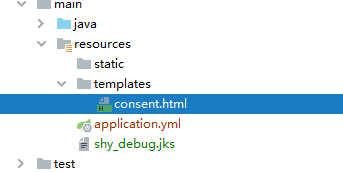
在这个目录下,代码如下
<!DOCTYPE html>
<html lang="en">
<head>
<meta charset="utf-8">
<meta name="viewport" content="width=device-width, initial-scale=1, shrink-to-fit=no">
<link rel="stylesheet" href="https://stackpath.bootstrapcdn.com/bootstrap/4.5.2/css/bootstrap.min.css"
integrity="sha384-JcKb8q3iqJ61gNV9KGb8thSsNjpSL0n8PARn9HuZOnIxN0hoP+VmmDGMN5t9UJ0Z" crossorigin="anonymous">
<title>Custom consent page - Consent required</title>
<style>
body {
background-color: aliceblue;
}
</style>
<script>
function cancelConsent() {
document.consent_form.reset();
document.consent_form.submit();
}
</script>
</head>
<body>
<div class="container">
<div class="py-5">
<h1 class="text-center text-primary">App permissions</h1>
</div>
<div class="row">
<div class="col text-center">
<p>
The application
<span class="font-weight-bold text-primary" th:text="${clientId}"></span>
wants to access your account
<span class="font-weight-bold" th:text="${principalName}"></span>
</p>
</div>
</div>
<div class="row pb-3">
<div class="col text-center"><p>The following permissions are requested by the above app.<br/>Please review
these and consent if you approve.</p></div>
</div>
<div class="row">
<div class="col text-center">
<form name="consent_form" method="post" action="/oauth2/authorize">
<input type="hidden" name="client_id" th:value="${clientId}">
<input type="hidden" name="state" th:value="${state}">
<div th:each="scope: ${scopes}" class="form-group form-check py-1">
<input class="form-check-input"
type="checkbox"
name="scope"
th:value="${scope.scope}"
th:id="${scope.scope}">
<label class="form-check-label font-weight-bold" th:for="${scope.scope}" th:text="${scope.scope}"></label>
<p class="text-primary" th:text="${scope.description}"></p>
</div>
<p th:if="${not #lists.isEmpty(previouslyApprovedScopes)}">You have already granted the following permissions to the above app:</p>
<div th:each="scope: ${previouslyApprovedScopes}" class="form-group form-check py-1">
<input class="form-check-input"
type="checkbox"
th:id="${scope.scope}"
disabled
checked>
<label class="form-check-label font-weight-bold" th:for="${scope.scope}" th:text="${scope.scope}"></label>
<p class="text-primary" th:text="${scope.description}"></p>
</div>
<div class="form-group pt-3">
<button class="btn btn-primary btn-lg" type="submit" id="submit-consent">
Submit Consent
</button>
</div>
<div class="form-group">
<button class="btn btn-link regular" type="button" id="cancel-consent" onclick="cancelConsent();">
Cancel
</button>
</div>
</form>
</div>
</div>
<div class="row pt-4">
<div class="col text-center">
<p>
<small>
Your consent to provide access is required.
<br/>If you do not approve, click Cancel, in which case no information will be shared with the app.
</small>
</p>
</div>
</div>
</div>
</body>
</html>
5.生成jks文件
windows下CMD命令窗口输入
keytool -genkeypair -alias shy_debug.jks -keyalg RSA -validity 7 -keystore shy_debug.jks
alias别名
然后根据提示输入相关信息,记好密码和别名,后面要用到
把生成的jks文件放到这里
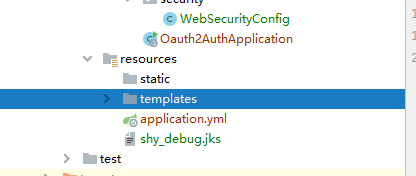
6.配置KeyPair
@Configuration
public class KeyPairConfig {
@Bean
public KeyPair keyPair() throws Exception {
ClassPathResource ksFile = new ClassPathResource("shy_debug.jks");//文件名
KeyStoreKeyFactory ksFactory = new KeyStoreKeyFactory(ksFile, "haiwei".toCharArray()); //第二个参数就是生成时候的密码
return ksFactory.getKeyPair("shy_debug.jks");
}
}
7.配置AuthorizationServerConfig授权服务器配置
@Configuration(proxyBeanMethods = false)
public class AuthorizationServerConfig {
private static final String CUSTOM_CONSENT_PAGE_URI = "/oauth2/consent";
@Autowired
private KeyPair keyPair;
@Bean
@Order(Ordered.HIGHEST_PRECEDENCE)
public SecurityFilterChain authorizationServerSecurityFilterChain(HttpSecurity http) throws Exception {
OAuth2AuthorizationServerConfigurer<HttpSecurity> authorizationServerConfigurer =
new OAuth2AuthorizationServerConfigurer<>();
authorizationServerConfigurer
.authorizationEndpoint(authorizationEndpoint ->
authorizationEndpoint.consentPage(CUSTOM_CONSENT_PAGE_URI));
RequestMatcher endpointsMatcher = authorizationServerConfigurer
.getEndpointsMatcher();
http
.requestMatcher(endpointsMatcher)
.authorizeRequests(authorizeRequests -> authorizeRequests
.anyRequest().authenticated()
)
.csrf(csrf -> csrf.ignoringRequestMatchers(endpointsMatcher))
.apply(authorizationServerConfigurer);
return http.formLogin(Customizer.withDefaults()).build();
}
// @formatter:off jdbc相关
@Bean
public RegisteredClientRepository registeredClientRepository(JdbcTemplate jdbcTemplate) {
// Save registered client in db as if in-jdbc
// 注意这里启动第一次写入客户端信息后一定要注释掉,不然每次启动都会新生成一个重复的客户端,后续会报错。如果已经报错,检擦数据库是否有重复数据,删掉重复的
RegisteredClient registeredClient = RegisteredClient.withId(UUID.randomUUID().toString())
.clientId("messaging-client")
.clientSecret("{noop}secret")
.clientAuthenticationMethod(ClientAuthenticationMethod.CLIENT_SECRET_BASIC)
.authorizationGrantType(AuthorizationGrantType.AUTHORIZATION_CODE)
.authorizationGrantType(AuthorizationGrantType.REFRESH_TOKEN)
.authorizationGrantType(AuthorizationGrantType.CLIENT_CREDENTIALS)
.redirectUri("http://127.0.0.1:8080/login/oauth2/code/messaging-client-oidc")
.redirectUri("http://www.baidu.com")
.scope(OidcScopes.OPENID)
.scope("message.read")
.scope("message.write")
.clientSettings(ClientSettings.builder().requireAuthorizationConsent(true).build())
.build();
// Save registered client in db as if in-memory
JdbcRegisteredClientRepository registeredClientRepository = new JdbcRegisteredClientRepository(jdbcTemplate);
registeredClientRepository.save(registeredClient);
return registeredClientRepository;
}
// @formatter:on
@Bean
public OAuth2AuthorizationService authorizationService(JdbcTemplate jdbcTemplate, RegisteredClientRepository registeredClientRepository) {
return new JdbcOAuth2AuthorizationService(jdbcTemplate, registeredClientRepository);
}
@Bean
public OAuth2AuthorizationConsentService authorizationConsentService(JdbcTemplate jdbcTemplate, RegisteredClientRepository registeredClientRepository) {
return new JdbcOAuth2AuthorizationConsentService(jdbcTemplate, registeredClientRepository);
}
@Bean
public JWKSource<SecurityContext> jwkSource() {
RSAKey rsaKey = generateRsa();
JWKSet jwkSet = new JWKSet(rsaKey);
return (jwkSelector, securityContext) -> jwkSelector.select(jwkSet);
}
public RSAKey generateRsa() {
RSAPublicKey publicKey = (RSAPublicKey) keyPair.getPublic();
RSAPrivateKey privateKey = (RSAPrivateKey) keyPair.getPrivate();
// @formatter:off
return new RSAKey.Builder(publicKey)
.privateKey(privateKey)
.keyID(UUID.randomUUID().toString())
.build();
// @formatter:on
}
@Bean
public ProviderSettings providerSettings() {
return ProviderSettings.builder().issuer("http://127.0.0.1:9500").build();
}
}
8.配置WebSecurityConfig基础security配置
@Configuration
@EnableWebSecurity(debug = true)
public class WebSecurityConfig {
@Bean
public SecurityFilterChain httpSecurityFilterChain(HttpSecurity httpSecurity) throws Exception {
httpSecurity
.authorizeRequests(authorizeRequests ->
authorizeRequests.anyRequest().authenticated()
)
.formLogin(withDefaults());
return httpSecurity.build();
}
/*private Converter<Jwt, AbstractAuthenticationToken> customJwtAuthenticationTokenConverter() {
return jwt -> {
List<String> userAuthorities = jwt.getClaimAsStringList("authorities");
List<String> scopes = jwt.getClaimAsStringList("scope");
List<GrantedAuthority> combinedAuthorities = Stream.concat(
userAuthorities.stream(),
scopes.stream().map(scope -> "SCOPE_" + scope))
.map(SimpleGrantedAuthority::new)
.collect(Collectors.toList());
String username = jwt.getClaimAsString("user_name");
return new UsernamePasswordAuthenticationToken(username, null, combinedAuthorities);
};
}*/
// @formatter:off
@Bean
UserDetailsService users() {
UserDetails user = User.withDefaultPasswordEncoder()
.username("admin")
.password("111111")
.roles("USER").authorities("test")
.build();
return new InMemoryUserDetailsManager(user);
}
// @formatter:on
}
9.配置AuthorizationConsentController
@Controller
public class AuthorizationConsentController {
private final RegisteredClientRepository registeredClientRepository;
private final OAuth2AuthorizationConsentService authorizationConsentService;
public AuthorizationConsentController(RegisteredClientRepository registeredClientRepository,
OAuth2AuthorizationConsentService authorizationConsentService) {
this.registeredClientRepository = registeredClientRepository;
this.authorizationConsentService = authorizationConsentService;
}
@GetMapping(value = "/oauth2/consent")
public String consent(Principal principal, Model model,
@RequestParam(OAuth2ParameterNames.CLIENT_ID) String clientId,
@RequestParam(OAuth2ParameterNames.SCOPE) String scope,
@RequestParam(OAuth2ParameterNames.STATE) String state) {
// Remove scopes that were already approved
Set<String> scopesToApprove = new HashSet<>();
Set<String> previouslyApprovedScopes = new HashSet<>();
RegisteredClient registeredClient = this.registeredClientRepository.findByClientId(clientId);
OAuth2AuthorizationConsent currentAuthorizationConsent =
this.authorizationConsentService.findById(registeredClient.getId(), principal.getName());
Set<String> authorizedScopes;
if (currentAuthorizationConsent != null) {
authorizedScopes = currentAuthorizationConsent.getScopes();
} else {
authorizedScopes = Collections.emptySet();
}
for (String requestedScope : StringUtils.delimitedListToStringArray(scope, " ")) {
if (authorizedScopes.contains(requestedScope)) {
previouslyApprovedScopes.add(requestedScope);
} else {
scopesToApprove.add(requestedScope);
}
}
model.addAttribute("clientId", clientId);
model.addAttribute("state", state);
model.addAttribute("scopes", withDescription(scopesToApprove));
model.addAttribute("previouslyApprovedScopes", withDescription(previouslyApprovedScopes));
model.addAttribute("principalName", principal.getName());
return "consent";
}
private static Set<ScopeWithDescription> withDescription(Set<String> scopes) {
Set<ScopeWithDescription> scopeWithDescriptions = new HashSet<>();
for (String scope : scopes) {
scopeWithDescriptions.add(new ScopeWithDescription(scope));
}
return scopeWithDescriptions;
}
public static class ScopeWithDescription {
private static final String DEFAULT_DESCRIPTION = "UNKNOWN SCOPE - We cannot provide information about this permission, use caution when granting this.";
private static final Map<String, String> scopeDescriptions = new HashMap<>();
static {
scopeDescriptions.put(
"message.read",
"This application will be able to read your message."
);
scopeDescriptions.put(
"message.write",
"This application will be able to add new messages. It will also be able to edit and delete existing messages."
);
scopeDescriptions.put(
"other.scope",
"This is another scope example of a scope description."
);
}
public final String scope;
public final String description;
ScopeWithDescription(String scope) {
this.scope = scope;
this.description = scopeDescriptions.getOrDefault(scope, DEFAULT_DESCRIPTION);
}
}
}
至此配置完毕
三 启动项目,这里我们测试授权码模式
浏览器输入 http://127.0.0.1:9500/oauth2/authorize?client_id=messaging-client&response_type=code&scope=message.read&redirect_uri=http://www.baidu.com
会转到登陆页面
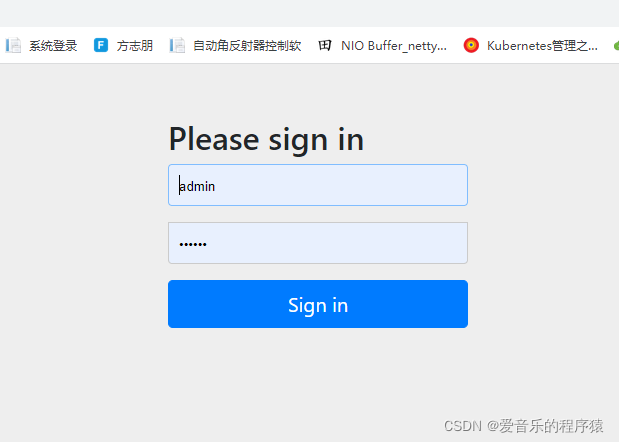
输入账号密码会跳转到认证授权页面
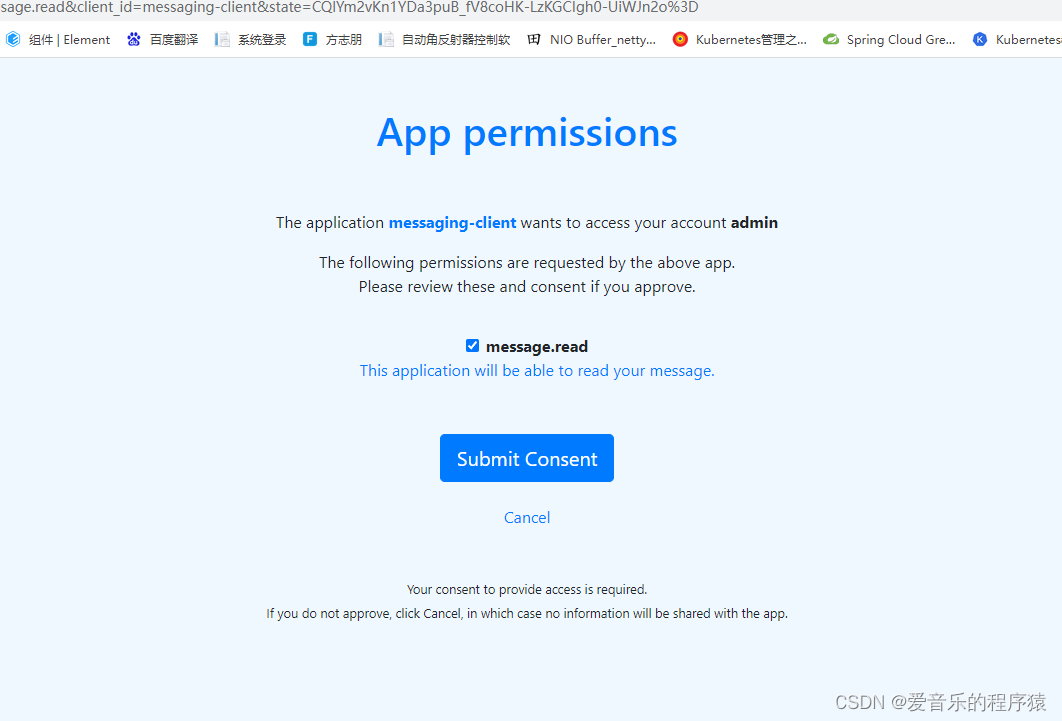
勾选上scope,点认证

这样就获取到code了
然后用postman请求

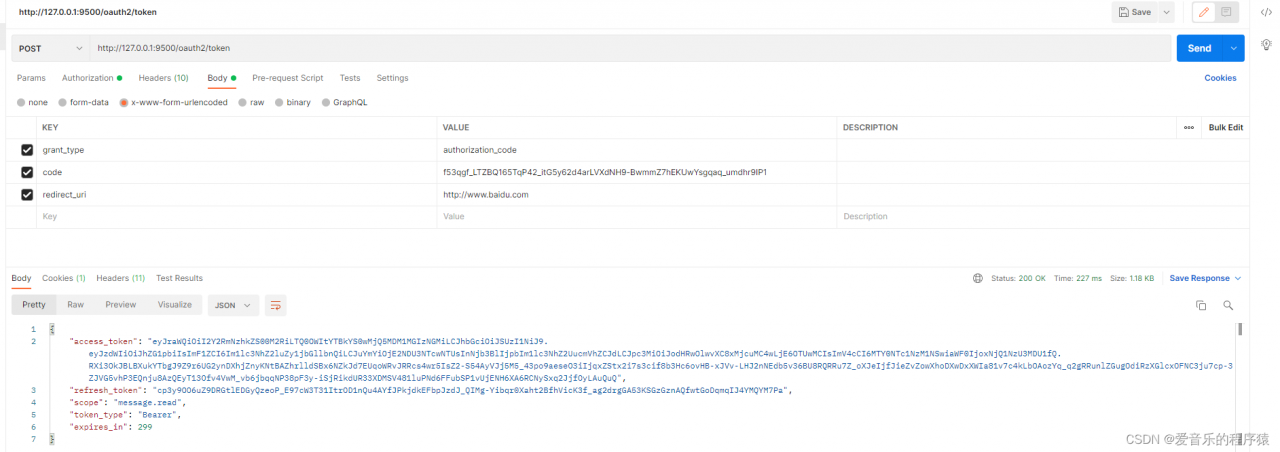
这样就获取到token了
总结
spring authorization server搭建完成,后面一篇文章我会说明资源服务器端如何接入认证服务器,资源服务器文章链接
spring authorization server授权服务器教程,资源服务器搭建接入认证服务器https://blog.csdn.net/qq_35270805/article/details/123146959